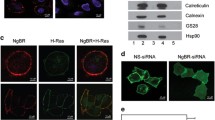Abstract
The catalytic domains of the Raf family of protein kinases (ΔRaf) differ in their ability to activate MEK in vitro and in vivo and in their ability to oncogenically transform mammalian cells. The kinase domain of B-Raf is more active than the equivalent portion of Raf-1 which in turn is more active than A-Raf. In Raf-1 the phosphorylation or mutation to aspartic acid of two key tyrosine residues upstream of the ATP binding site has been demonstrated to significantly potentiate catalytic activity. In A-Raf the analogous amino acids are also tyrosine whereas in B-Raf they are aspartic acid. To determine if these differences in amino acid sequence influence the relative catalytic activity of the Raf kinase domains we constructed forms of ΔA-Raf, DB-Raf and ΔRaf-1 that encode either aspartic acid [DD], phenylalanine [FF] or tyrosine [YY] at these positions. These proteins were expressed both in mammalian cells as fusions with the hormone binding domain of the estrogen receptor and as epitope-tagged proteins in Sf9 insect cells to test their oncogenic and catalytic potentials. When expressed in Rat1 or 3T3 cells in the presence of hormone all of the ΔRaf-1:ER and ΔA-Raf:ER proteins were transforming with the exception of the [FF] form of ΔA-Raf. In general the [DD] forms of the ΔRaf-1:ER and ΔA-Raf:ER proteins were the most potently oncogenic which correlated with their ability to elicit activation of the MAP kinase pathway. Consistent with the transformation data, the catalytic activity of the [DD] forms of ΔA-Raf:ER and ΔRaf-1:ER was about ten times greater than the cognate [FF] and [YY] forms of the proteins. By contrast all of the ΔB-Raf:ER proteins were highly transforming and ΔB-Raf catalytic activity was largely unaffected by mutation of the aforementioned aspartic acids to either tyrosine or phenylalanine. Similar results were obtained with epitope-tagged forms of ΔA-Raf, ΔB-Raf and ΔRaf-1 expressed in Sf9 cells. These data provide support for the model that key tyrosine residues in the protein kinase domains of A-Raf and Raf-1 are important in the regulation of catalytic activity. In addition they demonstrate that the higher intrinsic activity of B-Raf cannot be explained simply by the presence of aspartic acids at the analogous positions.
Similar content being viewed by others
Author information
Authors and Affiliations
Rights and permissions
About this article
Cite this article
Bosch, E., Cherwinski, H., Peterson, D. et al. Mutations of critical amino acids affect the biological and biochemical properties of oncogenic A-Raf and Raf-1. Oncogene 15, 1021–1033 (1997). https://doi.org/10.1038/sj.onc.1201270
Received:
Revised:
Accepted:
Issue Date:
DOI: https://doi.org/10.1038/sj.onc.1201270
- Springer Nature Limited
Keywords
This article is cited by
-
Raf kinases mediate the phosphorylation of eukaryotic translation elongation factor 1A and regulate its stability in eukaryotic cells
Cell Death & Disease (2012)
-
Prolonged activation of ERK1,2 induces FADD-independent caspase 8 activation and cell death
Apoptosis (2006)
-
Effects of a conditionally active v-ErbB and an EGF-R inhibitor on transformation of NIH-3T3 cells and abrogation of cytokine dependency of hematopoietic cells
Oncogene (2004)
-
JAK/STAT, Raf/MEK/ERK, PI3K/Akt and BCR-ABL in cell cycle progression and leukemogenesis
Leukemia (2004)
-
A positive-feedback-based bistable ‘memory module’ that governs a cell fate decision
Nature (2003)




